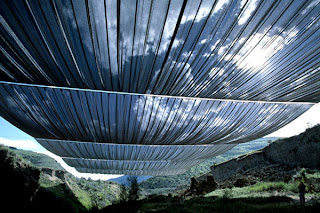I love big cities, the built environment, mind bending feats of modern technology, mammoth bridges that disappear into the horizon, cruise ships that scrape the top of the Miami skyline.
You know what's even more amazing? The exact opposite of all of that.
Natures wild prowess, its unrelenting strength, and its ability to completely eradicate the most monstrous of our creations.
Standing atop the Empire State Building proves the marvels of human engineering, but what's humbling is the view across the city and beyond, displaying the curvature of a wild planet that refuses to be tamed.
For years, artists Christo and Jean-Claude dreamed of draping Mother Nature's masterpiece in a drag queen's gown along six miles of the Arkansas River in Colorado. While Christo's website calls the project temporary - lasting only two weeks - he conveniently leaves out the two years it will take to construct.
I find outsider art interesting. In a genre of boring canvases and abstract nonsense, modern art rarely inspires me. But when it interacts with the environment, it often elicits an emotional response. Christo and Jean-Claude's The Gates of Central Park offered a bit of whimsy, contrasting the green backdrop of an urban oasis. Whether or not you consider The Gates art, its place was appropriate for the installation.
Likewise, Olafur Eliasson Waterfalls - while they certainly looked better on paper - were unique, and the concept fitting against the backdrop of the Manhattan skyline.
At best, the community in which they were installed applauded the artwork. At worst, New Yorkers found them a hackneyed studio prop that was at least clever. Whatever the community's opinion, their placement didn't really offend anyone because public art installations - good or bad - complement urban environments full of skyscrapers, towering bridges, and billboards.
One could even say that Christo and Jean Claude's The Gates and Eliasson's Waterfalls drew an environment of urban cynics into the nature they've forgotten. By offering a path into the woods, The Gates led urbanites to a forgotten forest while Waterfalls reminded New Yorkers of nature's mighty ferocity just upstream.
However, Christo's On The River does just the opposite. Instead of respectfully returning us back to that from which we're from, his project vandalizes our origins, our natural beginnings. And for what purpose?
Visitors come to New York for the architecture, the theater, the art. New Yorkers live there for the excitement, the careers and opportunities, and endure what can at times be a frustrating feat of human endurance with little reprieve. The same can be said for all cities.
But aside from the obvious, the differences between these two environments - the chaos we've built and the nature that rejuvenates us at our core - aren't completely parallel. We aren't rooted in urbanity. Spiritual solace cannot be found in Central Park, even with some orange flags as our guide.
Not far from our nation's Northeast Corridor, we are a people who've embraced our natural reserves, painstakingly preserving some of the world's most spiritual natural wonders.
There's a reason we don't build a Walmart within Yosemite National Park or put condos in the Grand Canyon, and for the exact same reasons, the Arkansas River in southern Colorado is protected from development, however temporary or small.
Although Christo is attempting to get the proper permits, his project is just as principally disrespectful as Sean Parker's illegal $10M fairy tale themed wedding in Big Sur, California. We leave only footprints, not rivets and I-beams.
His urban installations are often bankrolled
by municipalities who know they'll see a surge in tax revenue. Christo has convinced himself that city bureaucrats shell out millions to
wrap their landmarks and bridges in cellophane as if they're something far greater than a business tactic or tourist trap.
Unfortunately, there's a two dimensional divide between the international art community and those opposed to the project. While the implication, "we don't want you here," may be true, it's far from trite.
Those opposed to the project are not inherently unappreciative of art simply because they don't want Christo's work here. Likewise, those who support Christo's work aren't eagerly awaiting the destruction of this natural oasis.
On The River belongs atop the Vine Street Expressway, or any freeway canyon in the nation for that matter. There his message could echo that of The Gates, symbolizing to harried commuters a river and reminding them of the nature we replaced with our concrete jungles.
What does Christo's On The River state? What is his message? And most importantly, as an artist who design installations intended to compliment the environment and community in which they reside, who is his audience?
Will the urban art appreciator who flies to southern Colorado to see Christo's work stay long enough to explore Salida and Cañon City, it's peaceful nature, and appreciate Mother Nature's masterpieces? Or will the cynical urbanite within rear its ugly head, crowding six miles of vandalized wonderland, staring up at Christo's silver bunting, only to return to their hotel to mock the provincial townspeople?
Sure, that may be an unfair judgment call, but if you think for a second that won't happen, you're either clueless, or one of those cynics mocking my own appreciation for nature right now.
If you look at On The River and see a beautiful work of art, you're looking at the distraction, not the masterpiece.
Great artwork can, and occasionally should, be offensive, but only in the artwork itself. Christo's choice in setting signals a man who, while he may understand his own artwork, does not understand a world beyond his urban environment, and proven that while his artwork may be great, the offensiveness stems not from his work, but the man himself.
Striping buggy, 1960
2 days ago




No comments:
Post a Comment